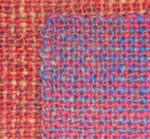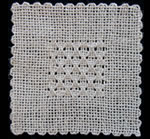![]()
Depending on the length of color repeat and where you start in the repeat, the woven result might be tweedy, plaid, checked, or subtly shaded from corner to corner. If the yarn is dyed to have an exact repeat, you can weave the exact same plaid over and over, then join the modules to make an overall plaid in the finished piece.
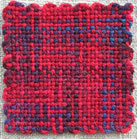 |
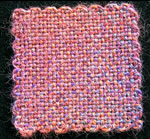 |
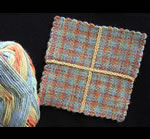 |
Color variation in plain weave
![]()
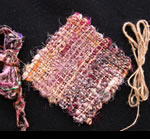 Fragile, bulky handspun silk for three layers. Final layer woven with fine, smooth handspun silk. |
Jazz up plain weave with texture. Chenille and nubby seed yarns usually don’t need special treatment Fragile yarns that cannot be needled through the last layer—like long eyelash and fur—can often be used in the first two or three layers, with a smooth, blending thread for the remainder of the weaving. |
![]()
| You don’t have to weave a unit with one weight of yarn. If you want to use a yarn that’s too heavy for all four layers, use the heavy yarn for the first two layers and a much finer yarn for the final wrap and needle-weaving. | 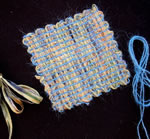 Bulky cotton/nylon ribbon & lace weight 2-ply alpaca |
![]()
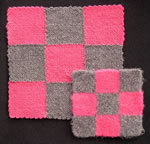 Before and After Felting |
Change the texture of plain weave with felting! I love this process and use it often. Sample first to get the finished felted size of the modules before you plan the project. This type of weaving will felt at the same rate both horizontally and vertically. You can seam before or after processing for completely different effects. |
![]()
![]()
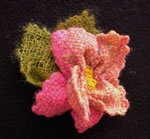 Wool and mohair Loom Bloom |
The shape of a plain weave piece can be manipulated by pulling selected threads in the warp and weft. The Loom Bloom project was featured in the 2005 winter issue of Spin-Off magazine (no longer available). |
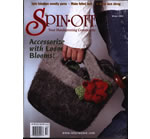 |
Yardage requirements for plain weave on some hand-held looms:
| 2" square Weave-It or Weavette |
2 yards |
|
| 4" square Weave-It or Weavette or Loomette |
7.5 yards | |
| 4.25" square—Bucilla Magic-Loom |
8.25 yds | |
| 2" X 4" Weavette rectangle | 4 yards | |
| 2" X 6" Weavette rectangle |
6 yards | |
| 4" X 6" rectangle Weavette | 11 yards | |
| 6" X 6" square Weavette | 16.25 yds | |
| 5" X 5" Weave-It Rug Loom | 5 yds, 30 inches | |
| 7” square Hazel Rose Loom | 18 yards for bias weave |
Buy extra yarn, to allow for sampling and unforeseen problems, such as knots in skeins and defects in yarn structure.


